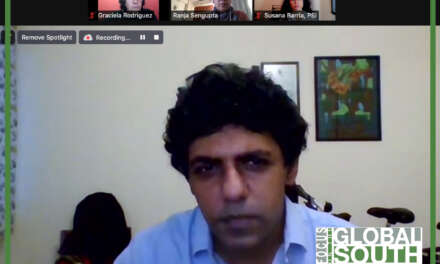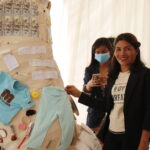Time to Abandon Doha and Move towards peoples' alternatives
The Doha negotiations have been suspended indefinitely. But while Member countries took note of and accepted the suspension as an inevitable course given the divergences on views and positions, majority of the Members including the Philippines continue to support the Doha Round and have expressed both their hopes that the negotiations could begin anew as soon as possible and their willingness to contribute to the effort to save it.
The desire by Member countries to save the round stem primarily from the view that the best chance for developing countries to get a fair trade deal is through a multilateral system. The fear of a collapse of the multilateral system therefore and the shift to more bilateral negotiations is the underlying motivation for any attempt to resuscitate the round in the coming months.
As Member countries now pause to reflect on the future of the round and the WTO, it is the time to revisit the Doha Negotiations, re-examine the positions that the Philippines have taken and take stock of what we have gained and lost in the process and begin the more critical work of recasting our trade policies.
For the Stop the New Round Coalition– a broad multi-sectoral coalition that has been campaigning against the Doha Round since 2003– the suspension of the Doha Round should be viewed as a wake up call to developing countries like the Philippines that the Doha Round betrays rather than promotes development. The collapse therefore of the current trade talks would in fact be a positive development for poor countries like the Philippines.
The continuing debate on many of the critical issues and the failure time and again of Member countries to come to a consensus should be a signal as well that it is time to explore alternatives to the WTO. A world beyond the WTO is indeed possible!
Development Denied
Five years ago, the Doha round was launched as a "development round" promising to put the interests of developing countries especially the least developed among them at the center of the negotiations. It is ironic that the anti-developmental nature of the WTO has become more evident under a so-called development round.
The Doha negotiations have become a struggle for developing countries against the aggressive and ambitious agenda to open new markets for agricultural and industrial goods and the fast track liberalization of the services sector.
A recent statement made by Susan Schwab, United States Trade Representative underscores the real objectives of the round. Speaking days after the collapse of Ministerial level talks in Geneva, Schwab insisted that "the only Doha deal the U.S. will accept is an ambitious one". As if on cue, Peter Mandelson the European Trade Commissioner stated a few days later that "the EU must pursue an aggressive agenda to open foreign markets to its goods and services even if the current round of world trade liberalization talks is successful."
More and more the burden of this ambitious liberalization agenda in terms of reduced tariff protections and higher tariff binding commitments is being shifted to developing countries while the benefits are skewed in favour of developed countries.
Doha: A Bad Deal for the Philippines
In agriculture, the new deal that's shaping up would have developing countries absorb further tariff cuts. For the Philippines, with an average bound rate for our agriculture products at a low 10 percent already and with an overwhelming majority of our tariff lines falling between 0-30 percent, the deal would reduce our average rate further to less than 7 percent.
On the other hand, the developed countries particularly the United States and the European Union would have the mandate still to continue their huge subsidy programs for their own farmers. The much publicized proposals from the US and the EU for 60 % cuts in their farm subsidies are no more than ‘paper cuts' that would not really redound to substantive reduction in their billion dollar domestic support to agriculture.
Furthermore, the demand made by the Philippines through the Group of 33 for special products and special safeguard mechanisms (SP/SSM), that aim to protect certain products which are vital to food security, livelihood and rural development, have continuously been challenged and watered down by developed countries who in turn want a special category of sensitive products for their own agriculture.
The area of special products and special safeguard mechanisms has become the foremost issue for the Philippines in the agriculture negotiations. Our agriculture negotiators came back from the Hong Kong Ministerial Meeting claiming a major gain on SP/SSM. They were confident that we could push an SP coverage of at least 20 % of agricultural tariff lines. This would translate to around 160 tariff lines that would be given some degree of cover from tariff reductions.
The recent developments in the agriculture negotiations however have effectively doused cold water on the Philippines hopes on SP/SSM. The proposal of the United States to limit the SP coverage to a mere 5 tariff lines has pulled down considerably the numbers on SP. Without a clear bottom line position on coverage, SP/SSM may no longer provide the much needed cover and flexibilities that the Philippines is hoping for.
In the negotiations on non-agricultural market access or NAMA, which deals with industrial and fishery sectors, developed countries are pushing for a very ambitious formula of tariff reduction and tariff bindings that is feared by many as closing the door to industrialization for developing countries. In NAMA, the burden of tariff reduction would again be carried by developing countries with developed countries absorbing reduction rates or around 20-25 percent as against the 60-80 percent reduction rates for developing countries. For the Philippines, aside from increasing our binding commitments to practically all products, a deal on NAMA would force us to peg our tariff rates on industrial and fishery products at their lowest ever. These tariff reductions would have tremendous effects on particular sectors like automotive, textiles, cement, petrochemical, shoes and fisheries.
In services, even as the push for more offers from developing countries to various approaches seemed to have back fired, the aggressive liberalization agenda on services remains evident. The big debate right now in the GATS negotiations is over domestic regulation. The proponents of services liberalization are pushing hard for the elimination of all barriers to liberalization and this includes challenging the right of countries to institute the necessary mechanisms and put in place policies that regulate the entry of foreign investments in the services sector.
Top down Process
The Doha round negotiations had become more and more exclusionary. The informal meetings among a few countries are overshadowing the formal processes in term of importance and influence. From Mini-ministerial meetings to green room discussion, to meetings of the Group of 6 (G6) and Group of 8 (G8), major decisions are now being made by a select few and the majority of the Members are being left out and marginalized in what is supposed to be a Member-driven, bottom-up process. That the decision to suspend the round in fact was an off shoot of the failure of the G6 countries to show movement in the critical areas is further proof of where the power in the WTO resides.
We have seen over the course of the negotiations more bullying and pressure tactics from the developed countries. The proposals from the United States for instance regarding special products and special safeguard mechanisms and on domestic regulation have shown its capacity to effectively undermine the demands of developing countries for flexibilities and more policy space.
Since Hong Kong, the negotiations have largely become a Geneva-based process concentrated on the work done by the various committees in order to facilitate the forging of consensus on the so called modalities in agriculture and NAMA and the new offers in services.
Lamy's Landing Zone: Crash landing for developing countries
Part of this effort initiated by WTO Director General Pascal Lamy was a mini Ministerial Conference in Geneva at the end of June 2006. The talks in Geneva collapsed and failed to come up with the necessary consensus on the modalities. The crisis however has been converted by Lamy to an opportunity to catalyze the stalled process. And with his new role has laid down his 20-20-20 proposal as a means to break the stalemate. Lamy's proposal outlines the possible ‘landing zone' on the key issues.
On agricultural market access, the proposal is to adopt the G20 proposal (which would have developed countries shoulder an average of 54% tariff cuts while developing countries adopt a 36% cut), on NAMA, Lamy proposes the adoption of the simple Swiss formula with coefficient of 20% for developing countries, and for domestic support, the proposal is for the United States to consider reducing its allowable trade distorting domestic support level to US$20 billion.
There remains a huge divergence on these critical issues but the positions are not totally unbridgeable and the major players and groupings have expressed willingness to exhibit flexibilities and adjust their own bottom lines forge a deal. Poor countries like the Philippines are again left with two choices. They can like dead fish, go with the flow and let the big trading powers have their way and accept a deal that would be detrimental to their own interest or they can resist and say no to the Doha Round.
Benefits for the rich, Losses for the poor
Recent studies have shattered the illusion that poor countries would be the main beneficiaries of the Doha Round. Economic estimates now show that not only have the projected gains from the round been reduced from a high of US%832 billion to around US$96 billion but perhaps more importantly that the high-income countries would corner as much as US$80 billion or 83 percent of the benefits. Furthermore, half of the gains of around US$16 billion for developing countries would just be shared by eight countries: Brazil, Argentina, China, India, Thailand, Vietnam, Mexico and Turkey.
Our negotiators should also give a closer look at the results of a recent study by the United Nations Conference on Trade and Development (UNCTAD) that predict losses in tariff income for developing countries under Doha could range between $32 billion and $63 billion annually.
The projections thus clearly show that developing countries stand to loss more than they gain in the Doha Round.
Suspended Animation
It remains uncertain when and how or if at all the Doha negotiations would resume. Given this critical juncture of uncertainty and crisis but at the same time an expected push to resuscitate the round, we in the Stop the New Round Coalition reiterate our demand on the Philippine Government to abandon the Doha Round on the basis that it would be detrimental to the interest of the country particularly the poor and marginalized sectors. Our national interest lies in preventing a lopsided deal favoring the rich countries from coming to fruition.
It is time to think of a world beyond Doha, a world beyond the WTO and start building and strengthening people's alternatives. An alternative system of global trade that protects livelihoods, promotes food sovereignty, secures jobs, and facilitates access to basic human needs like water, education, healthcare and affordable medicines. We should strive to build an alternative system of trade that is anchored on cooperation and not competition and where people's welfare matter more than profits.



![[Event Invitation] The Hague Tribunal Judgment on Conflicting Claims in the South China Sea: Implications for the Philippines, China, the United States, and ASEAN](https://focusweb.org/wp-content/uploads/2017/04/xspratlys_1-339x264.png.pagespeed.ic.j8iHbl6cB2.jpg)




